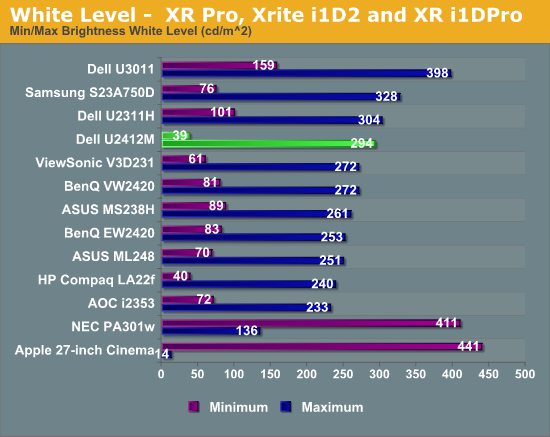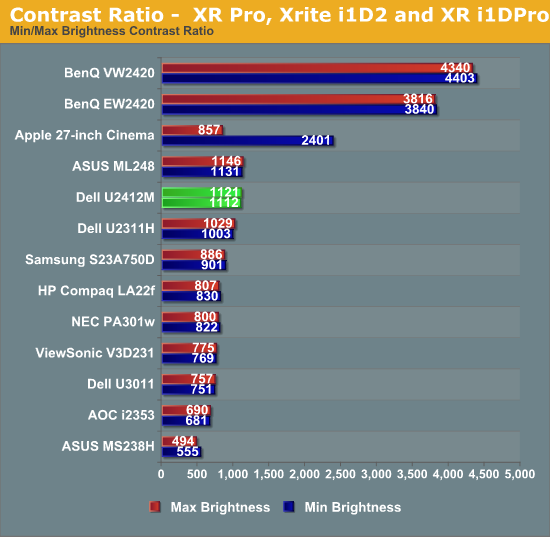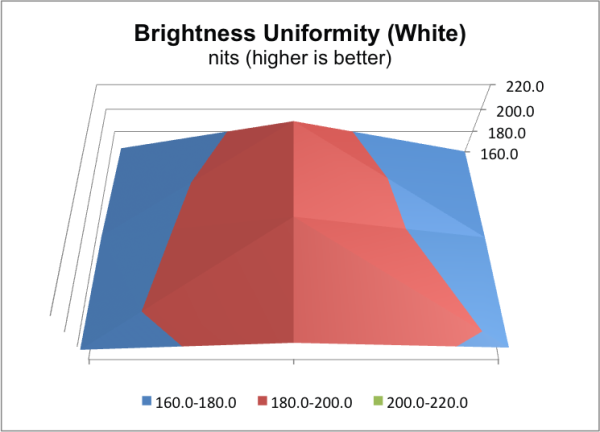Dell U2412M - 16:10 IPS without Breaking the Bank
by Chris Heinonen on February 28, 2012 9:00 AM ESTDell U2412M Brightness and Contrast
Despite the larger size of the display compared to recent 23” monitors I have reviewed, the U2412M says it can produce 300 nits of light at maximum output, which should certainly be bright enough for anyone to use. It’s worth noting that I usually set the display around 5 nits too high before calibration, to allow for a little headroom when ColorEyes generates the curves. However this also means that maximum light output, once calibrated, might be around 5% lower than maximum due to the curves inside the ICC profile.

Despite this possible limitation, the Dell still put out 294 nits at maximum brightness after calibration, and 39 nits at minimum brightness. This was plenty bright for my work area, even with bright overhead lights, and the combination of the high brightness and anti-glare coating made it easy to see the screen.
The weak area for IPS screens has always been the black levels, with them being much higher than those from VA based displays. The U2412M did well here, out performing all recent non-VA displays with a nice, low black level.

With this combination of black level and a very bright screen, we would expect to see a decent contrast ratio to come out as well, and the Dell delivers here.

Beating the specified number by over 10% is always nice to see, and the contrast on the Dell is very nice. It easily outperforms most TN displays, though it's not able to compete with the combination of LED lighting and a VA panel from BenQ. It was also very stable across the spectrum, with virtually identical ratios at maximum and minimum brightness.
While the center stayed nice and bright, the edges showed a good amount of fall off in comparison, and an overall variance of around 6%. The areas with higher brightness uniformity issues were also the areas with higher dE values on the uniformity testing, just as we expected. Looking at black uniformity, thanks to the bright corners this wound up even worse, with a variance of around 14%.
Taken as a whole, the contrast ratios are good, and while there is light fall-off at the edges of the display, it does not seem to have a noticeable effect on color quality.












143 Comments
View All Comments
Death666Angel - Tuesday, February 28, 2012 - link
Honestly, if I had to chose between 16:9 with 1080p or 16:10 with 900p, I'd take 16:9. The real issue people argue is that the 24" market has gone 16:9 with 1080p. No gamer or other user would go with anything below 22" unless there are space constraints.piroroadkill - Wednesday, February 29, 2012 - link
The U2410 is not a budget screen by any measure, though, and although it is "old", it is not actually old. It is still being sold alongside the U2412, because the U2410 has a true 8-bit S-IPS panel, 10-bit processing, wider gamut (almost all of AdobeRGB) and a slew of inputs.It's still relevant.
seapeople - Wednesday, February 29, 2012 - link
Dude, nobody cares about your low resolution 16:10 screens.Only very strange aspect ratio freaks think 1440x900 is better than 1920x1080 anyway.
It's cool to see a budget 1920x1200 monitor out there.
Burner.Tom - Tuesday, February 28, 2012 - link
The direct competitor to reviewed Dell monitor is HP ZR2440w 24-inch LED Backlit IPS Monitor, not ZR24 - its the previous generation.PS: Dell isnt the LCD panel maker - its LG, probably model LM240WU8.
Burner.Tom - Tuesday, February 28, 2012 - link
HP ZR2440w 24-inch LED Backlit IPS Monitor - Overviewhttp://h18000.www1.hp.com/products/quickspecs/1414...
darwinosx - Tuesday, February 28, 2012 - link
The HP is a tad bit more expensive but a much better deal with much better service. I'm surprised the author didn't know this was actually the competitor for this Dell not the old HP monitor.cheinonen - Tuesday, February 28, 2012 - link
For competitors I was specifically search for other IPS/VA panels with 1920x1200 resolution that were within $75 (or 25%) of the price of the Dell. The only model that came up at the time of searching was the older HP, which is why it was listed. There are a lot of other 16:10 IPS/VA panels, but once you got past being within 25% of the price, I didn't consider them direct competitors anymore.Burner.Tom - Tuesday, February 28, 2012 - link
U2412M and ZR2440w are direct competitors from hardware point of view (LCD panel) but the price is really better in Dell case.In Slovakia, its 253€ for Dell and 350€ for HP, both have 36 months On-site warranty. The question is - why is HP so expensive? I guess there must be something cheaper used in Dell monitor (power circuit, controller board, ...). Who is OEM of the Dell? ZR24w and ZR2440w are made by Tatung.
JarredWalton - Tuesday, February 28, 2012 - link
Wait, what makes the HP a "much better deal"? I'd call service of HP and Dell monitors pretty close to equal, and the HP is $50 more for the lowest price I can find. 15% more is only "a bit more"? They're both eIPS AFAICT, so other than the nebulous "service and support" aspect, why would one be better than the other?Touche - Tuesday, February 28, 2012 - link
HP has more inputs, a scaler for 1:1, thus can be hooked up to consoles, and better RTC control. The latter makes it a bit more responsive, but former to have higher input lag. Comparing several reviews, HP tends to have better uniformity.